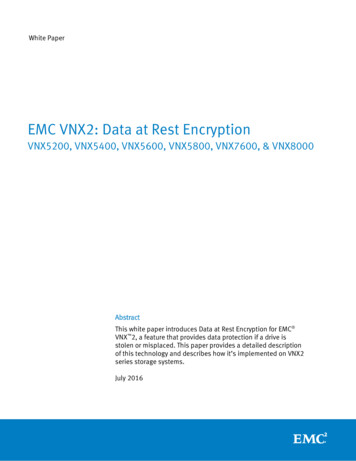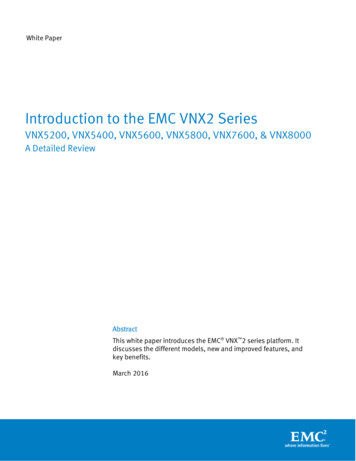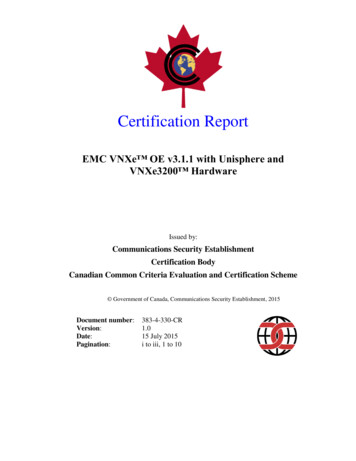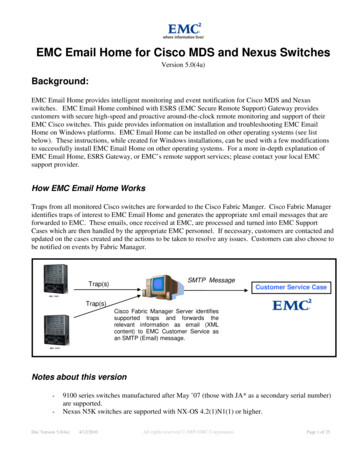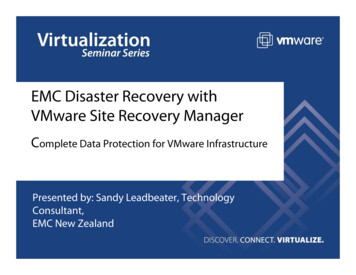
Transcription
EMC VNX2 Unified Best Practices forPerformanceApplied Best Practices GuideVNX OE for Block 05.33.008VNX OE for File 8.1.8EMC Core Technologies Division, VNX BUAbstractThis applied best practices guide provides recommended best practices forinstalling and configuring VNX2 unified storage systems for goodperformance.October 2015
Copyright 2015 EMC Corporation. All rights reserved. Published in the USA.Published October, 2015EMC believes the information in this publication is accurate of its publication date.The information is subject to change without notice.The information in this publication is provided as is. EMC Corporation makes norepresentations or warranties of any kind with respect to the information in thispublication, and specifically disclaims implied warranties of merchantability orfitness for a particular purpose. Use, copying, and distribution of any EMC softwaredescribed in this publication requires an applicable software license.EMC2, EMC, and the EMC logo are registered trademarks or trademarks of EMCCorporation in the United States and other countries. All other trademarks usedherein are the property of their respective owners.For the most up-to-date regulatory document for your product line, go to the technicaldocumentation and advisories section on EMC Online Support.EMC VNX2 Unified Best Practices for PerformanceApplied Best Practices GuidePart Number H10938.82EMC VNX2 Unified Best Practices for PerformanceApplied Best Practices Guide
ContentsChapter 1System Configuration . 7Essential guidelines . 8Storage Processor cache . 8Physical placement of drives. 8Hot sparing . 8Usage of flash drives in hybrid flash arrays . 9Availability and connectivity . 9Fibre Channel and iSCSI connectivity . 10NAS connectivity . 11Chapter 2Storage Configuration . 12General considerations . 13Drive type. 13Rules of thumb. 13RAID level. 14Calculating disk IOPS by RAID type. 14Determining which LUN type to configure. 15Creating LUNs for Block access . 16Creating LUNs for File access. 16Storage pool considerations . 17Storage pool creation and expansion . 17Pool capacity considerations . 18Storage tiers . 18Tiering policies. 19Storage pool object considerations . 19Storage pool LUNs for Block access . 19Storage Pool LUNs for File access . 20Classic RAID Group LUN considerations . 22Drive location selection . 22Classic RAID Group LUNs for Block access . 23EMC VNX2 Unified Best Practices for PerformanceApplied Best Practices Guide3
Classic RAID Groups for File access . 23Chapter 3Data Services . 25FAST VP . 26General . 26Data relocation . 26Pool capacity utilization . 26Considerations for VNX OE for File . 27Multicore FAST Cache . 27General considerations . 27Creating FAST Cache . 27Enabling Multicore FAST Cache on a running system . 27Data @ Rest Encryption. 28Replication. 28VNX Snapshots for Block LUNs . 28SnapView for Block LUNs . 29SnapSure checkpoints for file systems . 29MirrorView for Block LUN replication . 29RecoverPoint for Block LUN replication. 30IP Replicator for File System replication. 30Deduplication and compression . 30Block LUN compression . 30Block LUN deduplication . 30Deduplication and compression with VNX OE for File . 31Anti-virus . 32File system CAVA. 32Chapter 4Application Specific Considerations . 34Block application tuning . 35Host file system alignment . 35VMware ESX Server with iSCSI datastore . 35File application tuning . 35Hypervisor / Database over NFS or SMB . 35Bandwidth-intensive applications . 36Conclusion . 374EMC VNX2 Unified Best Practices for PerformanceApplied Best Practices Guide
PrefaceAs part of an effort to improve and enhance the performance and capabilities of itsproduct line, EMC from time to time releases revisions of its hardware and software.Therefore, some functions described in this guide may not be supported by allrevisions of the hardware or software currently in use. For the most up-to-dateinformation on product features, refer to your product release notes.If a product does not function properly or does not function as described in thisdocument, please contact your EMC representative.Note: This document was accurate as of the time of publication. However, asinformation is added, new versions of this document may be released to EMCOnline Support. Check the website to ensure that you are using the latestversion of this document.PurposeThe Applied Best Practices Guide delivers straightforward guidance to the majority ofcustomers using the storage system in a mixed business environment. The focus ison system performance and maximizing the ease of use of the automated storagefeatures, while avoiding mismatches of technology. Some exception cases areaddressed in this guide; however, less commonly encountered edge cases are notcovered by general guidelines and are addressed in use-case-specific white papers.Guidelines can and will be broken, appropriately, owing to differing circumstances orrequirements. Guidelines must adapt to: Different sensitivities toward data integrity Different economic sensitivities Different problem setsThese guidelines contain a few “DON’T” and “AVOID” recommendations: DON’T means: Do not do it; there is some pathological behavior AVOID means: All else being equal, it is recommended not to, but it stillacceptable to do itEMC VNX2 Unified Best Practices for PerformanceApplied Best Practices Guide5
AudienceThis document is intended for EMC customers, partners, and employees who areinstalling and/or configuring VNX2 unified systems. Some familiarity with EMC unifiedstorage systems is assumed.Related documentsThe following documents provide additional, relevant information. Access to thesedocuments is based on your logon credentials. All of the documents can be found onhttp://support.emc.com. If you do not have access to the following content, contactyour EMC representative.6 VNX2: Data at Rest Encryption Virtual Provisioning for the VNX2 Series - Applied Technology Introduction to the EMC VNX2 Series - A Detailed Review Introduction to EMC VNX2 Storage Efficiency Technologies VNX2 Multicore FAST Cache - A Detailed Review White Paper: VNX2 FAST VP - A Detailed Review White Paper: VNX2 Deduplication and Compression - Maximizing effectivecapacity utilization White Paper: VNX2 MCx - Multicore Everything White Paper: VNX Replication Technologies - An Overview White Paper: VNX Snapshots Host Connectivity GuideEMC VNX2 Unified Best Practices for PerformanceApplied Best Practices Guide
Chapter 1System ConfigurationThis chapter presents the following topics:Essential guidelines. 8Storage Processor cache . 8Physical placement of drives . 8Hot sparing. 8Usage of flash drives in hybrid flash arrays . 9Availability and connectivity . 9EMC VNX2 Unified Best Practices for PerformanceApplied Best Practices Guide7
Essential guidelinesThis guide introduces specific configuration recommendations that enable goodperformance from a VNX2 unified storage system. At the highest level, goodperformance design follows a few simple rules. The main principles of designing astorage system for performance are: Flash First – Utilize flash storage for the active dataset to achieve maximumperformance Distribute load over available hardware resources Design for 70 percent utilization (activity level) for hardware resources When utilizing Hard Disk Drives (HDD), AVOID mixing response-time-sensitiveI/O with large-block I/O or high-bandwidth sequential I/O Maintain latest released VNX Operating Environment versionStorage Processor cacheStorage Processor memory configuration is not required. Memory allocation amountsand cache page size are not configurable parameters.Physical placement of drivesWhen initially placing drives in the array: Spread flash drives across all available buses, and when possible place themin the lowest-numbered enclosures There are no restrictions around using or spanning across Bus 0 Enclosure 0Hot sparingHot sparing is the process of rebuilding a failed drive’s data onto a system-selectedcompatible drive. Any unbound non-system drive can be considered for sparing.When planning Hot Spares consider the following recommendations: Plan to reserve at least one of every 30 installed drives of a given typeoo 8Verify count in the GUI or CLI System- Hot Spare Policy naviseccli hotsparepolicy -listNote: Unbound system drives (Bus 0 Enclosure 0 Disk 0 through Disk 3)cannot be used as hot sparesEnsure that unbound drives for each drive type are availableoSAS Flash must spare for SAS FlashoSAS Flash VP must spare for SAS Flash VPoSAS must spare for SAS (regardless of rotational speed)EMC VNX2 Unified Best Practices for PerformanceApplied Best Practices Guide
oNL-SAS must spare for NL-SASThe capacity of an unbound drive should be equal to or larger than the provisioneddrives for which it will spare.Usage of flash drives in hybrid flash arraysEMC recommends the use of flash drives in VNX storage systems to maximize thepotential of the MCx operating environment. EMC recommends deploying flash drivesin the following priority order: Configure Multicore FAST Cache firstoMulticore FAST Cache is a global resource that can benefit all storageresourcesoNote: Multicore FAST Cache is not applicable for all-flash arraysNext, add a flash tier to pools containing thin LUNsoThe flash tier can accelerate access to thin LUN metadata, improvingperformanceoConfigure at least 3% of pool capacity in flash, to capture metadataoThin Provisioned LUNs, VNX Snapshots, Block Compression, andBlock Deduplication all rely on thin LUN technologyThen add a flash tier to pools utilizing FAST VPoConfigure at least 10% of pool capacity, for flash acceleration ofactive workloadoConfigure at least 25% of pool capacity, for near-all-flash performanceFinally, dedicate an all-flash pool to storage objects with very highperformance requirementsMore details on the effective use of flash drives for these purposes can be found inthe relevant sections in this paper.Availability and connectivityThe VNX2 unified storage array offers connectivity to a variety of client operatingsystems, and via multiple protocols, such as FC, iSCSI, NFS, and CIFS. EMC providesconnectivity guides with detailed instructions for connecting and provisioning storagevia different protocols to the specific host types.It is highly recommended that you consult connectivity documents onhttp://support.emc.com for the host types that will be connected to the array for anyspecific configuration options. Host connectivity guides cover more detail, especially for a particularoperating system; reference them for host-specific connectivity guidelinesEMC VNX2 Unified Best Practices for PerformanceApplied Best Practices Guide9
Fibre Channel and iSCSI connectivityFibre Channel connectivity is facilitated via the FC I/O modules on the Block StorageProcessors. iSCSI connectivity is facilitated via the iSCSI I/O modules on the BlockStorage Processors. Use multiple I/O ports on each SP, and balance host port connections acrossI/O ports, as host port connections affect the preferred CPU core assignment If not connecting all of the available I/O ports, use the even numbered portson each I/O module before using any odd numbered ports Initially skip the first FC and/or iSCSI port of the array if those ports areconfigured and utilized as MirrorView connections For the VNX8000, engage the CPU cores from both CPU sockets with Front EndtrafficoBalance the Front End I/O modules between slots 0-5 and slots 6-10 o DON’T remove I/O modules if they are not balanced; instead, contactEMC supportBalance host port assignments across I/O Module slots 0-5 and 6-10AVOID zoning every host port to every SP portWhen registering host HBAs with VNX OE for Block Storage Groups, make sure to setthe appropriate failover mode based on the host type. See the Host ConnectivityGuides for details.For Fibre Channel: Ensure that the FC ports connect at the highest speed supported by theenvironment, preferably 16Gb or 8Gb Consider the port count in use when performance targets are requiredo16Gb ports have a max capability of 90,000 IOPS, or 1,050 MB/so8Gb ports have a max capability of 60,000 IOPS, or 750 MB/sFor iSCSI: Use 10Gbps for the best performanceo Configure Jumbo Frames (MTU of 9000) on all iSCSI portso 1010Gb ports have a max capability of 40,000 IOPS, or 1,200 MB/sNote: The entire network infrastructure must also support Jumbo FramesWhen possible, segregate iSCSI traffic onto dedicated storage networksEMC VNX2 Unified Best Practices for PerformanceApplied Best Practices Guide
NAS connectivityNAS protocols (NFS and SMB/CIFS) are facilitated via I/O modules on the File datamovers. Use 10Gbps for the best performance Configure Jumbo Frames (MTU of 9000) on all NAS portso Note: The entire network infrastructure must also support Jumbo FramesIt’s recommended to use network trunking and multipathing to provide portfailover and greater aggregate bandwidth for NAS connections to a single DMoConfigure LACP across 2 or more ports on a single DM Use LACP instead of EtherChannelEMC VNX2 Unified Best Practices for PerformanceApplied Best Practices Guide11
Chapter 2Storage ConfigurationThis chapter presents the following topics:General considerations . 13Determining which LUN type to configure . 15Storage pool considerations . 17Storage pool object considerations . 19Classic RAID Group LUN considerations . 2212EMC VNX2 Unified Best Practices for PerformanceApplied Best Practices Guide
General considerationsDrive typeMatch the appropriate drive type to the expected workload:Drive typeWorkload typeFor extreme performance; these provide the best performance fortransactional random workloads, and the lowest write service times.SAS FlashRequired for Multicore FAST CacheSAS Flash VPFor extreme performance FAST VP tier; these are a higher capacityflash option.Not for use with Multicore FAST Cache.Rules of thumbSASFor general performance tier.NL-SASFor less active data, well-behaved streaming data, archive purposes,and backups.Disk drives are a critical element of unified performance. Use the rule of thumbinformation to determine the number of drives to use to support the expectedworkload.Rule of thumb data is based on drives that are: Operating at or below recommended utilization levels Providing reasonable response times Maintaining overhead to handle bursts or hardware failuresThese guidelines are a conservative starting point for sizing, not the absolutemaximums.Rules of thumb (RoT) for drive bandwidth (MB/s)BandwidthNL-SASSAS 10KSAS 15KFlash (All)RoT per drive,Sequential Read15 MB/s25 MB/s30 MB/s90 MB/sRoT per drive,Sequential Write10 MB/s20 MB/s25 MB/s75 MB/sThis chart gives the expected per-drive bandwidth of the different drive types whenservicing sequential workloads. Disk drives deliver optimal bandwidth when theworkload consists of: Large-block I/O (128KB or larger) Multiple concurrent sequential streamsEMC recommends the use of parity RAID (RAID-5 or RAID-6) for predominantlysequential workloads. When sizing for bandwidth with RoT, do not include paritydrives in the calculations. For example, to estimate the MB/s of a 4 1 RAID group , multiply theappropriate value from the chart by 4 (the number of non-parity drives)oSAS 15K, RAID-5 4 1, with sequential write: 4*25 MB/s 100 MB/sEMC VNX2 Unified Best Practices for PerformanceApplied Best Practices Guide13
Rules of thumb (RoT) for drive throughput (IOPS)ThroughputNL-SASSAS 10KSAS 15KSAS Flash VP (eMLC)SAS Flash (SLC)Per drive RoT90 IOPS150 IOPS180 IOPS3500 IOPS5000 IOPSThis chart gives the expected per-drive IOPS of the different drive types whenservicing multi-threaded random workloads. Disk drives deliver optimal IOPS whenthe workload consists of: Small-block I/O (64KB or smaller) Multiple parallel workload threads, sending concurrent activity to all drivesWhen drives are combined with RAID protection, additional drive I/O is needed toservice random writes from the host. To size for host IOPS, you must include the RAID overhead as described in thesection Calculating disk IOPS by RAID typeSystem drives (Bus 0 Disk 0 through Bus 0 Disk 3) have reduced performanceexpectations due to the management activities they support; rules of thumb for thesedrives are adjusted accordingly RAID levelNote: The system drives cannot be included in storage pools in the VNX2For best performance from the least number of drives, match the appropriate RAIDlevel with the expected workload:RAID levelExpected workloadRAID 1/0Works best for heavy transactional workloads with high (greater than30 percent) random writes, in a pool with primarily HDDsRAID 5Works best for medium to high performance, general-purpose andsequential workloadsRAID 6 for NL-SASWorks best with read-biased workloads such as archiving and backupto diskRAID 6 provides additional RAID protection to endure longer rebuildtimes of large drivesCalculating disk IOPS by RAID typeFront-end application workload is translated into a different back-end disk workloadbased on the RAID type in use.For reads (no impact of RAID type): 1 application read I/O 1 back-end read I/OFor random writes:14 RAID 1/0 -1 application write I/O 2 back-end write I/O RAID 5 -1 application write I/O 4 back-end disk I/O (2 read 2 write) RAID 6 -1 application write I/O 6 back-end disk I/O (3 read 3 write)EMC VNX2 Unified Best Practices for PerformanceApplied Best Practices Guide
Example for calculating disk IOPS from host IOPS:Host IOPS required 3000, with a read to write ratio of 2 to 1, using RAID 5.2 out of every 3 host I/O is a read.Disk reads (2*(3000/3)) 2000RAID 5 requires 4 disk I/O for every host write. 1 out of every 3 host I/O is awrite.Disk writes 4*(1*(3000/3)) 4000Total disk IOPS 2000 4000 6000If looking to support that required workload with 15K rpm SAS drives, onewould simply divide the rule of thumb into the required backend IOPS:6000/180 33.3, so round up to 35 to align with a preferred drivecount of the RAID 5 option.Determining which LUN type to configureThe VNX2 storage system supports multiple types of LUNs to meet the demands ofdifferent workloads and support different features. In general, Thin Pool LUNs arerequired for Block space efficiency features. Pool LUNs in general (either Thin orThick) are required for FAST VP tiering. Classic RAID Group LUNs do not providesupport for advanced features.In terms of performance: Thin LUNs provide good performance for most workloads Thick LUNs can provide higher performance than Thin, given the sameplatform and drive complement, by removing the CPU and IOPS load of certainfeatures Classic RAID Group LUNs provide the most consistent performance levels, forenvironments where variance in performance cannot be tolerated.Use the following charts to determine which is appropriate for your environment.EMC VNX2 Unified Best Practices for PerformanceApplied Best Practices Guide15
Creating LUNs for Block accessWhen creating a Block LUN, determine the desired feature set for this LUN from thechart below, and then create the appropriate LUN type.See the appropriate sections in this document for best practice recommendations forconfiguring the LUN type and features selected.Creating LUNs for File accessVNX OE for File builds file systems using Block LUNs. When creating Block LUNs forFile, determine the desired feature set for from the chart below, and then create theappropriate LUN type.See the appropriate sections in this document for best practice recommendations forconfiguring the LUN type and features selected.16EMC VNX2 Unified Best Practices for PerformanceApplied Best Practices Guide
Storage pool considerationsStorage pool creation and expansionCreate multiple pools in order to: Separate workloads with different I/O profilesoPredominantly sequential workloads should be placed in dedicated poolsor Classic RAID Groups Dedicate resources, when you have specific performance goals Vary pool parameters, such as Multicore FAST Cache enabled/disabled Minimize failure domainsoAlthough unlikely, loss of a private RAID group in the pool compromisesthe total capacity of that pool; it may be desirable to create multiplesmaller pools rather than configure the total capacity into a single poolStorage pools have multiple RAID options per tier for preferred type and drive count Consider the following rule of thumb for tier construction:oExtreme performance flash tier: 4 1 RAID 5oPerformance SAS tier: 4 1 or 8 1 RAID 5oCapacity NL-SAS tier: 6 2 or 8 2 RAID 6oNote: Classic RAID Groups pools have different recommended preferreddrive counts as described in the section on Classic RAID Group creationUse RAID 5 with a preferred drive count of 4 1 for the best performanceversus capacity balanceo Using 8 1 improves capacity utilization at the expense of reducedavailabilityUse RAID 6 for NL-SAS tieroPreferred drive counts of 6 2, 8 2, or 10 2 provide the best performanceversus capacity balanceoUsing 14 2 provides the highest capacity utilization option for a pool, atthe expense of slightly lower availability and performanceUse RAID 1/0 when a high random write rate ( 30%) is expected with HDDoFor best possible performance with RAID 1/0, use the largest availablepreferred drive count (i.e., 4 4 3 3 2 2, etc.)Recommendations for creating and expanding storage pools: When creating a pool, it is best to specify a multiple of the preferred drivecount for each tier you configureo For example, when using RAID 5 4 1, specify a drive count of 5, 10, 15,etc.It is best to maintain the same capacity and rotational speed of all driveswithin a single tier of a given poolEMC VNX2 Unified Best Practices for PerformanceApplied Best Practices Guide17
oFor example, AVOID mixing 600GB 10K SAS drives in the same pool with300GB 15K SAS drives; instead, split them into 2 different pools Within a given pool, use all of the same flash technology for the extremeperformance tier When expanding pools, use a multiple of the preferred drive count already inuse for the tier being expandedPool capacity considerationsIt is recommended to leave approximately 10% free space in the storage pool, toaccommodate data services.Note: The pool can still be over-subscribed above 100% of actual capacity; the 10%referenced here refers to actual free capacity that is not used in the pool. FAST VP requires free space to perform efficient relocations; it attempts tokeep 10% free per tier VNX Snapshots requires at least 5% free to buffer snapped writes Block Deduplication uses free space to buffer write-splits Maintaining a total of 10% free will meet the requirements of all featuresNote: By default, the VNX2 will begin issuing alerts when more than 70% of availablecapacity has been subscribed.AVOID over-subscribing pools which contain thin LUNs for VNX File. Storage tiersVNX File requires free space in the storage pool for normal functioningThe number of tiers required in a storage pool is influenced by the following: Performance requirements Capacity requirements Knowledge of the skew between active and inactive capacityThe capacity required for each tier depends on expectations for skew, which is thelocality of active data within the total storage capacity. Best performance is achievedwhen the entire active dataset can be contained within the capacity of the ExtremePerformance (flash) and Performance (SAS) tiers.As a starting point, consider capacity per tier of 10 percent flash, 20 percent SAS, and70 percent NL-SAS. This works on the assumption that less than 30 percent of theused capacity will be active and infrequent relocations from the lowest tier will occur.If the active capacity is known, the capacity per tier should be sized accordingly. Bestperformance is achieved when the active capacity fits entirely in the top tier.In summary, follow these guidelines: When Multicore FAST Cache is available, use a 2-tier pool comprised of SASand NL-SAS and enable Multicore FAST Cache as a cost-effective way ofrealizing flash performance without dedicating flash to this poolo18Flash tier can be added later if Multicore FAST Cache is not fully capturingthe active dataEMC VNX2 Unified Best Practices for PerformanceApplied Best Practices Guide
For a 3-tier pool, start with 10 percent flash, 20 percent SAS, and 70 percentNL-SAS for capacity per tier if skew is not knowno Tiering policiesTiers can
EMC Core Technologies Division, VNX BU Abstract This applied best practices guide provides recommended best practices for installing and configuring VNX2 unified storage systems for good performance. October 2015 EMC VNX2 Unified Best Practices for Performance Applied Best Practices Guide VNX OE for Block 05.33.008 VNX OE for File 8.1.8
